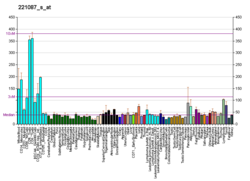Protein-coding gene in the species Homo sapiens
| APOL3 |
|---|
|
| Identifiers |
|---|
| Aliases | APOL3, APOLIII, CG121, CG12_1, apoL-III, apolipoprotein L3 |
|---|
| External IDs | OMIM: 607253; HomoloGene: 129701; GeneCards: APOL3; OMA:APOL3 - orthologs |
|---|
| Gene location (Human) |
|---|
 | | Chr. | Chromosome 22 (human)[1] |
|---|
| | Band | 22q12.3 | Start | 36,140,330 bp[1] |
|---|
| End | 36,166,177 bp[1] |
|---|
|
| RNA expression pattern |
|---|
| Bgee | | Human | Mouse (ortholog) |
|---|
| Top expressed in | - granulocyte
- monocyte
- apex of heart
- gastric mucosa
- pericardium
- lymph node
- spleen
- subcutaneous adipose tissue
- right lung
- tendon of biceps brachii
|
| | | More reference expression data |
|
|---|
| BioGPS |  | | More reference expression data |
|
|---|
|
| Gene ontology |
|---|
| Molecular function | - signal transducer activity
- lipid binding
- lipid transporter activity
| | Cellular component | - cytoplasm
- extracellular region
- membrane
| | Biological process | - lipoprotein metabolic process
- positive regulation of I-kappaB kinase/NF-kappaB signaling
- lipid transport
- inflammatory response
- signal transduction
- transport
| | Sources:Amigo / QuickGO |
|
| Orthologs |
|---|
| Species | Human | Mouse |
|---|
| Entrez | | |
|---|
| Ensembl | | |
|---|
| UniProt | | |
|---|
| RefSeq (mRNA) | NM_014349
NM_030644
NM_145639
NM_145640
NM_145641
|
|---|
NM_145642 |
| |
|---|
| RefSeq (protein) | NP_055164
NP_085147
NP_663614
NP_663615
NP_663616
|
|---|
NP_663617 |
| |
|---|
| Location (UCSC) | Chr 22: 36.14 – 36.17 Mb | n/a |
|---|
| PubMed search | [2] | n/a |
|---|
|
| Wikidata |
|
Apolipoprotein L3 is a protein that in humans is encoded by the APOL3 gene.[3][4] Expressed in the gut, it has antibiotic properties.[5]
This gene is a member of the apolipoprotein L gene family. The encoded protein is found in the cytoplasm, where it may affect the movement of lipids or allow the binding of lipids to organelles. In addition, expression of this gene is upregulated by tumor necrosis factor-alpha in endothelial cells lining the normal and atherosclerotic iliac artery and aorta. Six transcript variants encoding three different isoforms have been found for this gene.[4]
References
- ^ a b c GRCh38: Ensembl release 89: ENSG00000128284 – Ensembl, May 2017
- ^ "Human PubMed Reference:". National Center for Biotechnology Information, U.S. National Library of Medicine.
- ^ Page NM, Butlin DJ, Lomthaisong K, Lowry PJ (May 2001). "The human apolipoprotein L gene cluster: identification, classification, and sites of distribution". Genomics. 74 (1): 71–8. doi:10.1006/geno.2001.6534. PMID 11374903.
- ^ a b "Entrez Gene: APOL3 apolipoprotein L, 3".
- ^ Gaudet RG, Zhu S, Halder A, Kim BH, Bradfield CJ, Huang S, et al. (2021). "A human apolipoprotein L with detergent-like activity kills intracellular pathogens". Science. 373 (6552): eabf8113. doi:10.1126/science.abf8113. PMC 8422858. PMID 34437126. S2CID 235915023.
External links
Further reading
- Horrevoets AJ, Fontijn RD, van Zonneveld AJ, de Vries CJ, ten Cate JW, Pannekoek H (May 1999). "Vascular endothelial genes that are responsive to tumor necrosis factor-alpha in vitro are expressed in atherosclerotic lesions, including inhibitor of apoptosis protein-1, stannin, and two novel genes". Blood. 93 (10): 3418–31. doi:10.1182/blood.V93.10.3418.410k23_3418_3431. PMID 10233894.
- Dunham I, Shimizu N, Roe BA, Chissoe S, Hunt AR, Collins JE, et al. (December 1999). "The DNA sequence of human chromosome 22". Nature. 402 (6761): 489–95. Bibcode:1999Natur.402..489D. doi:10.1038/990031. PMID 10591208.
- Duchateau PN, Pullinger CR, Cho MH, Eng C, Kane JP (April 2001). "Apolipoprotein L gene family: tissue-specific expression, splicing, promoter regions; discovery of a new gene". Journal of Lipid Research. 42 (4): 620–30. doi:10.1016/S0022-2275(20)31171-8. PMID 11290834.
- Monajemi H, Fontijn RD, Pannekoek H, Horrevoets AJ (April 2002). "The apolipoprotein L gene cluster has emerged recently in evolution and is expressed in human vascular tissue". Genomics. 79 (4): 539–46. doi:10.1006/geno.2002.6729. PMID 11944986.
- Matsuda A, Suzuki Y, Honda G, Muramatsu S, Matsuzaki O, Nagano Y, et al. (May 2003). "Large-scale identification and characterization of human genes that activate NF-kappaB and MAPK signaling pathways". Oncogene. 22 (21): 3307–18. doi:10.1038/sj.onc.1206406. PMID 12761501.
- Collins JE, Wright CL, Edwards CA, Davis MP, Grinham JA, Cole CG, et al. (2005). "A genome annotation-driven approach to cloning the human ORFeome". Genome Biology. 5 (10): R84. doi:10.1186/gb-2004-5-10-r84. PMC 545604. PMID 15461802.
- Ma J, Dempsey AA, Stamatiou D, Marshall KW, Liew CC (March 2007). "Identifying leukocyte gene expression patterns associated with plasma lipid levels in human subjects". Atherosclerosis. 191 (1): 63–72. doi:10.1016/j.atherosclerosis.2006.05.032. PMID 16806233.














